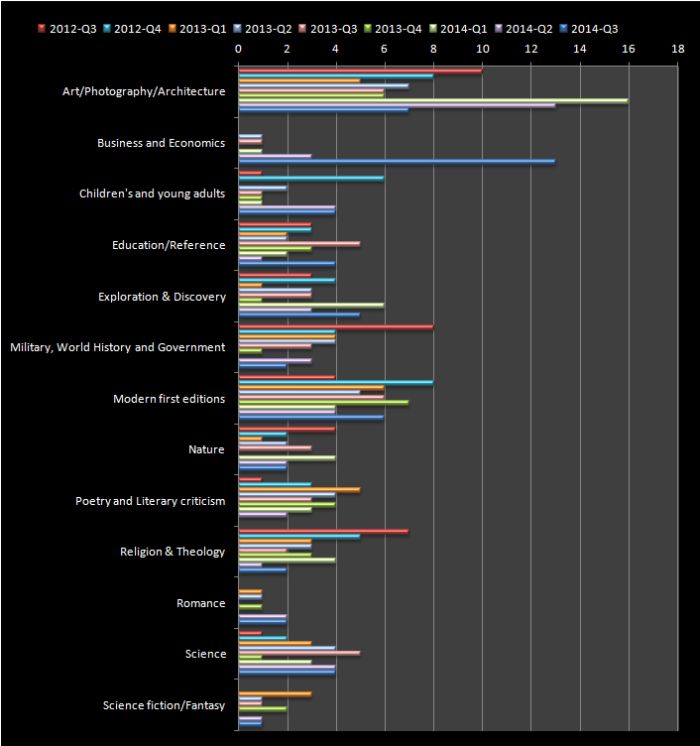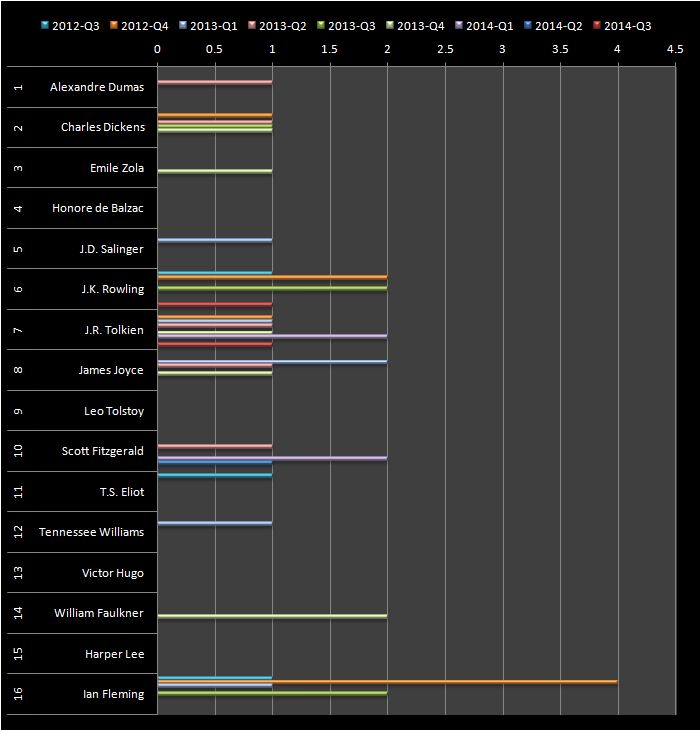 The Rare Book Sale Monitor (RBSM) analyzes prices of rare books traded at on-line marketplaces, auctions and various book fairs to report valuation trends by genre and author. The data collection process remained relatively static since the original collection was built back in 2011. The RBSM engine, however, has undergone several improvements in order to tackle some of the complexities associated with the heterogeneity of rare books.
The Rare Book Sale Monitor (RBSM) analyzes prices of rare books traded at on-line marketplaces, auctions and various book fairs to report valuation trends by genre and author. The data collection process remained relatively static since the original collection was built back in 2011. The RBSM engine, however, has undergone several improvements in order to tackle some of the complexities associated with the heterogeneity of rare books.
Liquidity is one such factor recently incorporated into the engine. While changes in pricing trends may be of great value to collectors and investors of rare books, the factor of liquidity is often ignored. For those not familiar with the term, liquidity is a measure of the ability to sell an item for cash when so desired. In other words, it is an indication of the difficulty or ease associated with finding a buyer. Often times, sellers are forced to lower their price below market valuation in order to turn it to a quick sale and cash. Books that lack liquidity are usually under considerable pricing pressure.
As in the case of commodity exchanges, the primary determinant of liquidity is the spread between bidding price (bid) and asking price (ask). Whether selling on-line, at an auction, or bookstore, etc., there is a certain price that the seller is asking for and whether it trades at that price, depends on whether a bidder is willing to buy it at that price. Rare books at the high end of the market tend to exhibit less liquidity trading on-line, than those put up in an auction with a limited timeframe and more dynamic bidding. The seller without time constraints would rather wait for the price to rise, thus setting a higher ask price and contributing to the valuable book’s liquidity indirectly. The further apart the ask verses the bid, the bigger the spread, the less liquid.
Incorporating the factor of time into the RBSM algorithms is significant. In a market that is considered to lack much liquidity relative to the stock market for example, the factor of time is considerably more important in measuring price changes. For example, a rare book that sold for twice its estimated value after being available for sale for a year should be of lesser importance than a similar sale for twice its estimated worth that was in the market for merely a day before being sold.
During the 3rd Quarter of 2014 the RBSM recorded a significant price change in the genre of “Exploration & Discovery.” While sales for the genre throughout this time period registered no change for the most part, an event held by Christies on September 30th reversed that trend. The second sale of the Brooke-Hitching library managed to sell 348 books on Exploration and Discovery, with just two lots remaining unsold. In general, well-organized live auction events with the time factor constraint, are usually less successful at pushing for higher prices even though they do provide an ideal platform for determining market valuations.
The comparables used from this event signified a price increase unanimously. In fact 95% of the books sold at this auction got sold at a higher price than the top end of their estimated valuation. Our own featured complete collection of all 7 octavo Dobbs-Middleton controversy pamphlets sold for £212,500, registering the biggest percentage gain above its valuation at the high end of the event’s offerings.
Liquidity for rare books in general has improved with the introduction of newer channels such as the on-line marketplaces. The market as a whole is presently more efficient and the aggregate of all channel sellers and buyers leads to a closer spread between bid and ask. In the future, RBSM workings will engage even more transaction types in order to capture a more accurate pricing trend. Will the pricing trend for “Exploration & Discovery” continue to increase? 2015 will bring two further sales of the Franklin Brooke-Hitching collection in the spring and autumn. RBSM will be there.



{ 0 comments… add one now }
{ 2 trackbacks }